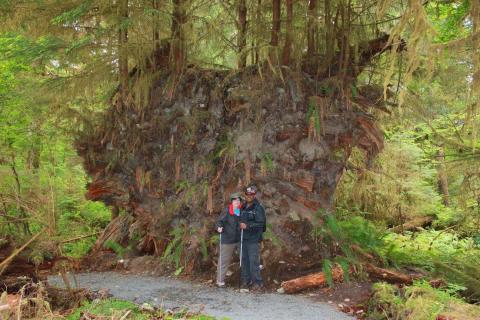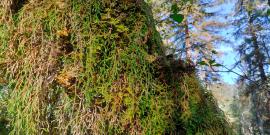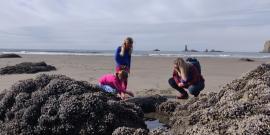
Marvel at Moss with Experience Olympic in the Hoh Rainforest
The Hoh Rainforest is a great sightseeing and hiking destination from September to July and is good for birding during spring migration and up until July.
Private guided nature tours can be scheduled as half day tours from Forks (where Carolyn meets you in Forks M-F at 7:15 AM) or as a full day (8 hour) tour from Port Angeles (departing no later than 6 AM).
Visiting the Hoh Rainforest is best enjoyed with a guide because you will learn about elk and temperate rainforest ecology and will enjoy Fairy Barf lichen.
Best Time of Year to Visit the Hoh Rainforest
The Hoh Rainforest is dripping in moss, ripe with summer berries, and ablaze in fall color. April, May and June are when the forest is green with new growth; July and August are flush with wild berries; September is when you can hear the male elk bugling; and October brings fall colors and excellent mushroom diversity.
Ancient Sitka Spruce and Western Hemlock dominate in this river valley that receives upwards of 130 inches of rain on average a year. Moss is incredibly prolific on all surfaces, especially when it creates curtains on maples and other surfaces. One dominate species that is not seen when touring outside the rainforest is Selaginella oregana what we call "curtain" moss to describe its growth habit.
Where to Stay and Arriving Early in the Morning to the Hoh Rainforest
Since Experience Olympic operates out of Port Angeles, it is a 4 hour (180 mile) roundtrip drive to the Hoh Rainforest. However, your guide can meet you in Forks on weekdays and recommends you consider staying overnight in Forks if you have extra vacation time. Two of our Multi-Day tours are organized to enjoy the Hoh Rainforest.
The Hoh Rainforest is a special place to visit but everything from road access, parking area, trails, visitor center, and campground were designed for a limited number of people to visit. We will get you there early in the morning or you can schedule an overnight tour to enjoy the rainforest in the evening and help you savor the biodiversity of this very special place.
Enjoy the Highest Living Standing Biomass
The placard for Olympic National Park's World Heritage Site designation is housed at the Visitor Center in Hoh Rainforest.
According to Unesco, the Hoh Rainforest has a living standing biomass which may be the highest in the world and contains one of the world’s largest stands of undisturbed temperate rainforest.
Lack of disturbance is reflected in the gigantic proportions of Hoh Rainforest trees including Sitka Spruce, Western Hemlock, Western Red Cedar, Big-Leave Maple, and Douglas Fir.
Roosevelt Elk in the Hoh Rainforest
The aptly named Hoh Rainforest Visitor Center Elk herd (or Campground Herd) usually resides within a mile radius of the Hoh Rainforest Visitor Center year-round.
Additionally, multiple Roosevelt Elk herds can be observed during the drive to the Hoh Rainforest Visitor Center in winter and spring.
While most of these herds move into the mountains during the summer and fall, the Hoh Visitor Center herd is the exception and typically does not stray far from the Visitor Center year round.
Mossy Silence in an Ancient Rainforest
The Hoh Rainforest is where Gordon Hempton has designated One Square Inch of Silence and Nalini Nadkarni made the discovery that Big-Leaf Maple roots were growing into canopy moss.
When you visit, you will notice what happens to forest on the Olympic Peninsula that is outside of the national park boundary and you will likely be thankful for the 95% wilderness designation.
Temperate rainforest patches exist in different regions of the world but expansive undisturbed old-growth rainforest like the Hoh Rainforest is rare.
Rain mostly comes in Winter to the Rainforest
Typical Northwest rains usually start in October and move us into winter. Intense rain and overcast days start to subside in April and then precipitation will almost completely stop in July.
Climate in Washington State is influenced by the Aleutian low (named for the Aleutian Islands), a climatic low-pressure feature that influences cyclones in winter and shifts north and disappears in the summer.
The North Pacific High (located between California and Hawaii during the winter) shifts north in the summer bringing us warm weather.
Hoh Rainforest - Ancient Groves and Lots of Rain
Definitions vary but latitude and average rainfall are key determinants of a temperate rainforest like the Hoh Rainforest (the wettest forest in the lower 48).
Some of the terraces above the Hoh River have not been disturbed by flooding, landslides, fire, or logging for hundreds to thousands of years.
Plus, all the dead wood in the form of snags (dead standing trees) and nurse logs (decomposing logs that act as a sponge for new plants to survive the dry summers) are key features of these old forests.
Rainforest vs. Rainshadow
Different parts of the Olympic Peninsula receive different amounts of rainfall based on weather systems coming off the Pacific Ocean and the relative position of the Olympic Mountains that break up these storms.
The west side of Lake Crescent is on-average wetter than the east side and as you continue east to Port Angeles and Sequim (which only receives 17 inches of rain on average a year) there is less average annual rainfall. This difference in rainfall from west-side to east-side is called the Rainshadow Effect.
The east-side of the Olympic Mountains have different dominant plant communities based on less rain.
Why Coastal Forest Can Feel More Like a "Rainforest" in August
The Hoh Rainforest starts at about 400 feet elevation and is about 30 river miles from the Pacific Ocean. During late July to early September there is little to no precipitation in the Hoh Rainforest. Plants and animals must adapt to deal with less water, intense sunlight, and heat.
Since fog is common only a few miles inland, coastal forests retain more of a damp "rainforest" like feel even during summer. Our favorite places in August are the mountains, coastal beaches, and coastal forests.


